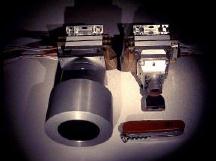 | |||||
|
| Mars Color Imager (MARCI) |
|---|
MARCI combines Wide Angle (WA) and Medium Angle (MA) cameras with individual optics but identical focal plane assemblies, data acquisition system electronics, and power supplies. Each camera is small in size (Å 6 x 6 x 12 cm, including baffle) and mass (combined mass ² 2 kg). Both cameras operate in a "pushframe" mode, with their CCD detectors overlaid with spectral ("color") filter strips. The cameras are electronically shuttered at intervals timed so that the spacecraft motion spatially overlaps each filter strip view, thereby providing a "color" composite. The MARCI Principal Investigator is Dr. Michael Malin (Malin Space Science Systems, San Diego).
Near the end of the Orbiter's cruise phase, MARCI acquires approach
images of Mars. Once in the mapping orbit, MARCI provides daily
global images of the Mars atmosphere (and surface) with the WA
camera and monitors surface changes with the MA camera during
mission periods with high data rates.
The WA camera has seven spectral bands [5 visible, 2 UV] and has spatial resolutions on the planet better than 7.2 km/pixel, for nominal orbital altitude and downlink data rates. Kilometer-scale resolutions are possible, when data rates permit. Limb observations detail the atmospheric structure of clouds and hazes at Å 4 km resolution. The MA camera has a 6_ FOV covering 40 km at 40 m/pixel (nadir) and accessing all positions of the planet (except the rotational poles due to the slight inclination of the spacecraft orbit). Ten spectral channels from 425 to 1000 nm provide the ability to discriminate both atmospheric and surface features on the basis of composition.
| Home | Mars Climate Orbiter | Mars Polar Lander | Deep Space 2 Microprobes |
| Welcome | Mailing List | Links | Credits |
For questions or comments on this website please refer to our list of contacts.
